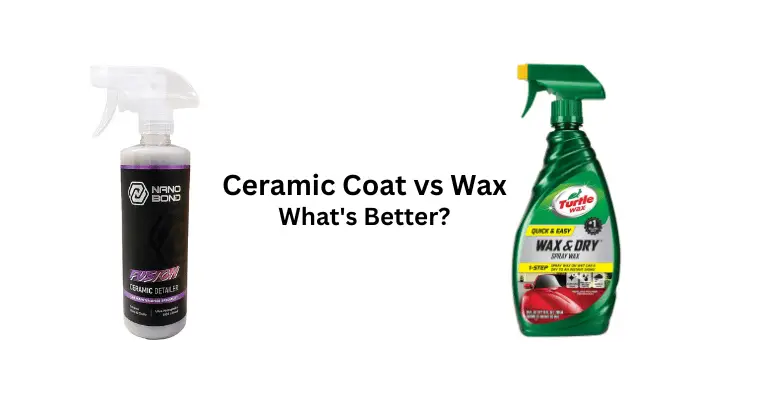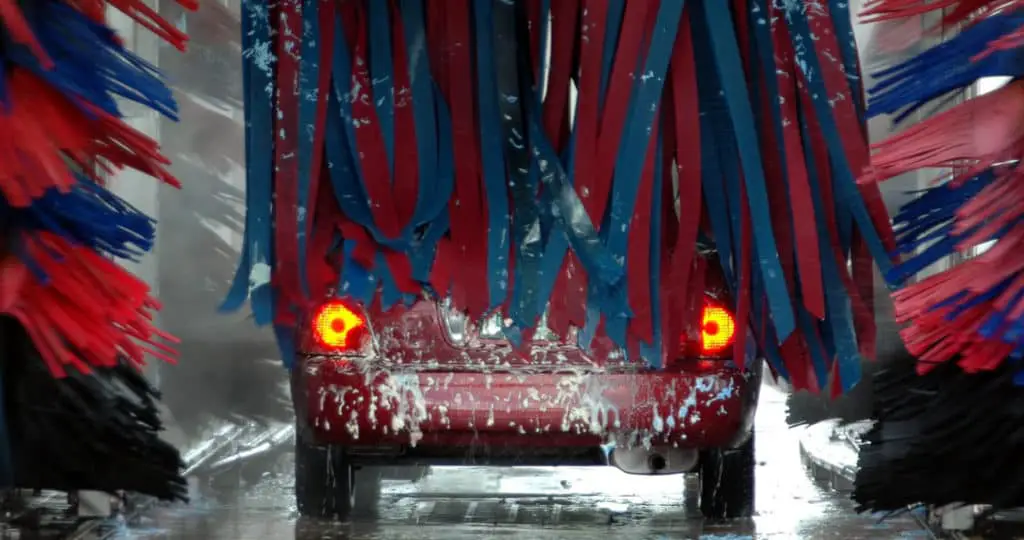- How to Clean Car Carpets Quickly (Without An Extractor) - July 10, 2024
- Can You Touch Up Clear Coat On A Car? Yes and No (Here’s Why) - November 25, 2023
- How To Wax A Car By Hand (For Beginners) - November 14, 2023
Last Updated on January 16, 2025 by Nate Schnell
When it comes to protecting your car’s paintwork, few debates are as enduring as the one between ceramic coating and car wax. Both options promise to keep your vehicle looking pristine, but they take very different approaches. So, how do you decide which is right for you?
This guide breaks down the differences, strengths, and limitations of both ceramic coatings and wax, helping you make an informed choice.
Why Paint Protection Matters
Your car’s exterior faces constant exposure to UV rays, rain, dirt, and road salt. Over time, these elements can dull your car’s finish and even damage the paint. A protective layer, whether it’s wax or ceramic coating, acts as a barrier, enhancing the car’s appearance and preserving its value.
What Is Car Wax?
Wax has been a staple in automotive care for decades. Made from natural substances like carnauba or synthetic polymers, wax creates a thin, water-repellent layer that temporarily protects the paint and enhances shine.
Car Wax Highlights: Wax is affordable, easy to apply at home, and provides a warm, glossy finish. However, its protection typically lasts only 4–6 weeks and is prone to washing off in harsh conditions.
What Is Ceramic Coating?
Ceramic coating is a liquid polymer that chemically bonds with the paint, forming a semi-permanent layer. Unlike wax, ceramic coating integrates with the paint for longer-lasting protection.
Ceramic Coating Advantages: Ceramic coatings offer years of protection, resist UV rays and chemicals, and make water bead off the surface. The finish is glossy and showroom-quality. However, ceramic coatings require meticulous application and are more expensive upfront.
Key Differences Between Ceramic Coating and Wax
- Durability: Wax needs frequent reapplication, while ceramic coatings can last years.
- Cost: Wax is budget-friendly initially, but ceramic coatings can save money over time with fewer applications.
- Application Process: Waxing is simple and quick, whereas ceramic coatings demand precision and often professional expertise.
- Level of Protection: Ceramic coatings provide superior resistance to environmental damage.
Choosing the Right Option
The choice between ceramic coating and wax depends on how you use your vehicle and your maintenance preferences.
- If your car is a daily driver exposed to the elements, ceramic coating offers low-maintenance, long-term protection.
- For show cars or collectibles that prioritize a warm, rich glow, wax can deliver stunning results.
- If you’re looking for a cost-effective way to maintain your vehicle’s shine and don’t mind frequent reapplications, wax is a great option.
Cost Considerations
A good-quality wax costs $20–$40 and takes only a few hours to apply. In contrast, ceramic coatings can range from $100 for DIY kits to $600 or more for professional applications. Though the upfront cost of ceramic coating is higher, the long-lasting protection can make it a more cost-effective solution in the long run.
Maintenance Tips for Both
Maintaining your paint protection is essential, regardless of the option you choose:
- Wax should be reapplied every 4–6 weeks and cleaned with pH-neutral shampoos.
- Ceramic coatings should be maintained with ceramic-safe detailing sprays and mild cleaners to preserve their hydrophobic properties.
Final Verdict
Both ceramic coatings and wax provide valuable protection but serve different needs. Wax is perfect for those who want an easy, affordable solution with a traditional glow, while ceramic coatings cater to drivers who prioritize long-term protection and minimal upkeep.
Ultimately, the best choice depends on your budget, how you use your vehicle, and how much time you’re willing to spend on maintenance. With consistent care, either option can keep your car looking its best for years to come.



